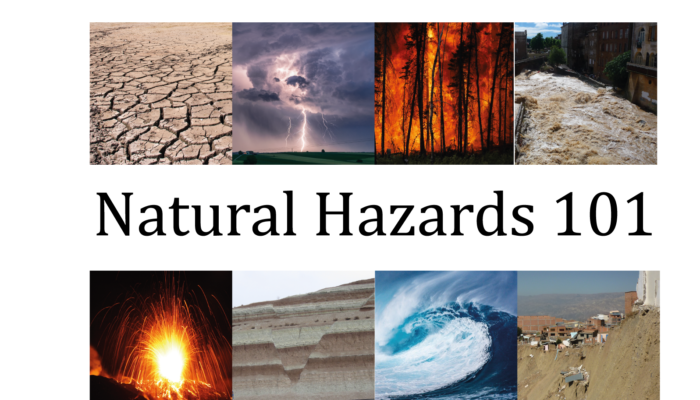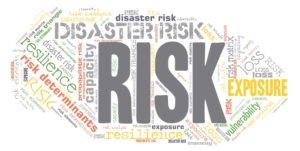
In the first episode of the series of posts called Natural Hazards 101, we focused on the definition of hazard and natural hazard, considering the recent literature. In this episode, we wish to draw your attention to the concept of risk. Although a commonly used word, the term risk might mean different things to different people. What does risk represent, and what it means in the context of natural hazards? Let’s have a look at the most common definitions found in the literature.
The most common use of the word risk is found in the dictionary to define a situation that involves being exposed to danger or loss or the chance that something bad will happen [1]. The Global Assessment Report on Disaster Risk Reduction (UNISDR) defines risk as ‘the combination of the probability of an event and its negative consequences’ [2]. According to this definition, the concept of risk can be seen as forward-looking, incorporating the possibility of some event that will occur and its adverse impact. How can this concept be interpreted in the context of natural hazards? In this simple probabilistic analysis, the risk a community faces from flooding, for example, can be estimated considering the likelihood that the nearby river will flood the area, causing losses among inhabitants, damage to assets and disruptions in the economic activities [3].
Looking at the terminology used in disaster risk management, disaster risk is described as the ‘potential loss of life, injury, or destroyed or damaged assets which could occur to a system, society or a community in a specific period of time, determined probabilistically as a function of hazard, exposure, vulnerability and capacity’ [4]. Thus, the occurrence of a natural hazard, as defined in the first episode, is not the only driver of risk and the disruption or damage caused by the occurrence of a tsunami, for example, relates to conditions of exposure, vulnerability and capacity that may lead to loss of life, damage to assets, economic and environmental loss. Let’s have a look at these concepts – determinants of risk – in more detail.

Image created using www.wordart.com.
Exposure is the state of being exposed to something harmful [1]; as a term, exposure defines the presence of people, infrastructure, housing and other tangible human assets, as well as economic activities, in a hazard-prone area [5] and includes all components that might be exposed to and affected by the natural hazard. Exposure can have different dimensions addressing the physical (buildings, infrastructure, other tangible assets), social (people) or economic (economic functions) aspects. Exposure is a necessary determinant of risk; if the population or assets are not located in a potentially dangerous setting (for example, a flood zone), they are not at risk from the specific natural hazard (no exposure) [3].
Vulnerability is a concept with many definitions and is often linked to the tendency to ‘be adversely affected’ when impacted by a hazardous event [3]. In the Hazard Definition and Classification Review (UNDRR), vulnerability is defined as ‘the conditions determined by physical, social, economic and environmental factors or processes which increase the susceptibility of an individual, a community, assets or systems to the impacts of hazards’ and is related to the predisposition, susceptibility, fragility, deficiency, or lack of capacity of a system that may be adversely affected [3]. Vulnerability can have many dimensions relating to the physical aspect of the structures or tangible assets or the characteristics of the socio-economic processes.
It is worth mentioning that there are various frameworks developed for defining vulnerability in disaster risk management, many of which rely on the assessment of capacity. UNDRR [5] describes capacity as the combination of characteristics and available resources in a community to manage and reduce risks and strengthen resilience; thus, the ability of a system or a community exposed to a specific natural hazard to resist, absorb, accommodate, adapt to, transform and recover from its effects in a timely and efficient manner [4].
How do these concepts define risk? In 2012 the Intergovernmental Panel on Climate Change (IPCC) published a special report on Managing the Risks of Extreme Events and Disasters to Advance Climate Change Adaptation, which discusses the key determinants of risk, exposure and vulnerability. Exposure is known as a necessary condition, but on its own, it does not imply increased risk; while an area can be exposed, it may not be vulnerable to a specific hazard. However, the area needs to be exposed to be vulnerable to a hazard.
References:
[1] Waite, M. and Hawker, S. (2009) Oxford Dictionary and Thesaurus. Third Edit. Oxford: Oxford University Press (OUP)
[2] UNISDR (2015) Global Assessment Report on Disaster Risk Reduction. Annex 1: GAR Global Risk Assessment: Data, Methodology, Sources and Usage
[3] Field C.B., Barros V., S. T. F., Qin D., Dokken D.J., Ebi K.L., Mastrandrea M.D., Mach K.J., Plattner G.-K., A. S. K. and Tignor M., and M. P. M. (eds.) (2012) Managing the Risks of Extreme Events and Disasters to Advance Climate Change Adaptation. Edited by Intergovernmental Panel on Climate Change (IPCC). Cambridge, UK and New York, USA: Cambridge University Press
[4] United Nations (2016) Report of the open-ended intergovernmental expert working group on indicators and terminology relating to disaster risk reduction.
[5] United Nations Office for Disaster Risk Reduction (2020) Hazard definition and classification review.
[6] Cardona, O.-D. and Van Aalst, M. K. (2012) Determinants of Risk: Exposure and Vulnerability, Managing the risks of extreme events and disasters to advance climate change adaptation. Special Report of the Intergovernmental Panel on Climate Change. Edited by I. P. on C. Change. Cambridge University Press.
[7] Official Journal of the European Union (2019) Reporting Guidelines on Disaster Risk Management, Art. 6(1)d of Decision No 1313/2013/EU, 2019/C 428/07.
Read episode 1: What is a -natural- hazard?
Read episode 3: The disaster cycle.
Post edited by Valeria Cigala and Gabriele Amato.



John Sekajugo
Good platform. We can share alot here. My name is John Sekajugo, a PhD researcher on environmental hazard assessment and risk analysis using a citizen science approach. Am focusing on landslides and floods in South Western Uganda
Asimina Voskaki
Thank you, John! Keep following us!
Would you consider writing an article as a guest author?
If yes, please get in touch!
Januka
Can you add a print button to download these articles as pdfs? Thanks!
Vale Cigala
Hi Januka,
I’ll make sure your question arrives at the EGU Blogs webmaster and see if that is possible.
Etta Prosper
Good blog. Thanks for the information on this blog I have learned a lot. My name is Etta prosper a final year masters student at the University of Yaounde 1 specialist in environmental Dynamics and Risk. My research is on Vulnerability of population to the effects of floods and mass movement in Limbe city, Cameroon.
Vale Cigala
Hi Etta!
Thank you for your comment, I’m happy you found the blog post useful.
Together with a group of great early-career scientists, we have a Slack channel where we can network and organise activities around the EGU General Assembly as well as outreach and so on, like the blog.
If you are interested to join, please drop an email to ecs-nh@egu.eu!